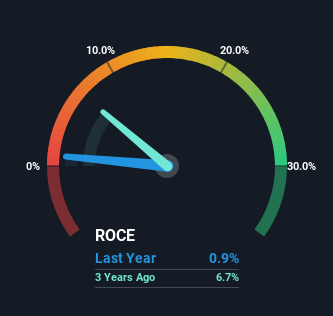- Germany
- /
- Hospitality
- /
- MUN:KVO
Here's What's Concerning About Oberstdorfer Bergbahn's (MUN:KVO) Returns On Capital
If we want to find a potential multi-bagger, often there are underlying trends that can provide clues. Amongst other things, we'll want to see two things; firstly, a growing return on capital employed (ROCE) and secondly, an expansion in the company's amount of capital employed. Put simply, these types of businesses are compounding machines, meaning they are continually reinvesting their earnings at ever-higher rates of return. Although, when we looked at Oberstdorfer Bergbahn (MUN:KVO), it didn't seem to tick all of these boxes.
Return On Capital Employed (ROCE): What Is It?
For those who don't know, ROCE is a measure of a company's yearly pre-tax profit (its return), relative to the capital employed in the business. Analysts use this formula to calculate it for Oberstdorfer Bergbahn:
Return on Capital Employed = Earnings Before Interest and Tax (EBIT) ÷ (Total Assets - Current Liabilities)
0.0089 = €263k ÷ (€32m - €2.3m) (Based on the trailing twelve months to November 2022).
Thus, Oberstdorfer Bergbahn has an ROCE of 0.9%. Ultimately, that's a low return and it under-performs the Hospitality industry average of 4.5%.
Check out our latest analysis for Oberstdorfer Bergbahn

While the past is not representative of the future, it can be helpful to know how a company has performed historically, which is why we have this chart above. If you'd like to look at how Oberstdorfer Bergbahn has performed in the past in other metrics, you can view this free graph of past earnings, revenue and cash flow.
What The Trend Of ROCE Can Tell Us
On the surface, the trend of ROCE at Oberstdorfer Bergbahn doesn't inspire confidence. Over the last five years, returns on capital have decreased to 0.9% from 8.0% five years ago. However, given capital employed and revenue have both increased it appears that the business is currently pursuing growth, at the consequence of short term returns. If these investments prove successful, this can bode very well for long term stock performance.
On a related note, Oberstdorfer Bergbahn has decreased its current liabilities to 7.3% of total assets. That could partly explain why the ROCE has dropped. What's more, this can reduce some aspects of risk to the business because now the company's suppliers or short-term creditors are funding less of its operations. Some would claim this reduces the business' efficiency at generating ROCE since it is now funding more of the operations with its own money.
The Key Takeaway
While returns have fallen for Oberstdorfer Bergbahn in recent times, we're encouraged to see that sales are growing and that the business is reinvesting in its operations. In light of this, the stock has only gained 24% over the last five years. So this stock may still be an appealing investment opportunity, if other fundamentals prove to be sound.
One more thing: We've identified 4 warning signs with Oberstdorfer Bergbahn (at least 3 which are potentially serious) , and understanding them would certainly be useful.
While Oberstdorfer Bergbahn isn't earning the highest return, check out this free list of companies that are earning high returns on equity with solid balance sheets.
New: AI Stock Screener & Alerts
Our new AI Stock Screener scans the market every day to uncover opportunities.
• Dividend Powerhouses (3%+ Yield)
• Undervalued Small Caps with Insider Buying
• High growth Tech and AI Companies
Or build your own from over 50 metrics.
Have feedback on this article? Concerned about the content? Get in touch with us directly. Alternatively, email editorial-team (at) simplywallst.com.
This article by Simply Wall St is general in nature. We provide commentary based on historical data and analyst forecasts only using an unbiased methodology and our articles are not intended to be financial advice. It does not constitute a recommendation to buy or sell any stock, and does not take account of your objectives, or your financial situation. We aim to bring you long-term focused analysis driven by fundamental data. Note that our analysis may not factor in the latest price-sensitive company announcements or qualitative material. Simply Wall St has no position in any stocks mentioned.
About MUN:KVO
Oberstdorfer Bergbahn
Engages in the operation of the Söllereck skiing and hiking area in Germany.
Low risk and slightly overvalued.
Market Insights
Community Narratives



